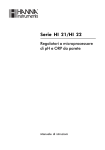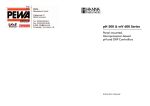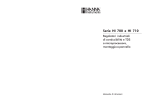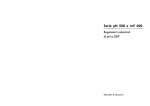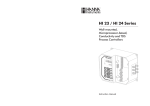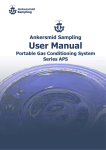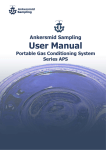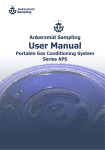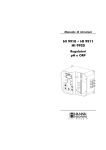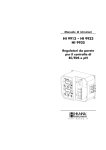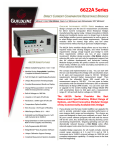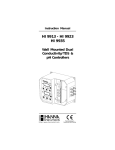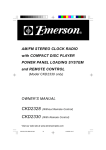Download HI 21/HI 22 Series - Electrocomponents
Transcript
HI 21/HI 22 Series Wall-mounted, Microprocessor-based Process pH/mV Meters Instruction Manual Dear Customer, Thank you for choosing a Hanna Product. Please read this instruction manual carefully before using the instrument. It will provide you with the necessary information for the correct use of the instrument, as well as a precise idea of its versatility. If you need additional technical information, do not hesitate to e-mail us at [email protected] [email protected]. These instruments are in compliance with the directives. TABLE OF CONTENTS PRELIMINARY EXAMINATION . . . . . . . . . . . . . . . . . . 4 GENERAL DESCRIPTION . . . . . . . . . . . . . . . . . . . . . 4 FUNCTIONAL DESCRIPTION . . . . . . . . . . . . . . . . . . 6 MECHANICAL DIMENSIONS . . . . . . . . . . . . . . . . . . 7 SPECIFICATIONS HI 21 & HI 22 . . . . . . . . . . . . . . . 8 INSTALLATION . . . . . . . . . . . . . . . . . . . . . . . . . . . . 9 SETUP MODE . . . . . . . . . . . . . . . . . . . . . . . . . . . . 11 MODELS The models HI 21XYZ are pH controllers, while the models HI 22XYZ are ORP controllers. CONTROL MODE . . . . . . . . . . . . . . . . . . . . . . . . . 17 IDLE MODE . . . . . . . . . . . . . . . . . . . . . . . . . . . . . 25 HI 21111 HI 21211 HI 21221 HI 21222 HI 21523 HI 22111 HI 22122 pH Controller with single setpoint, ON/OFF control, analog output pH Controller with dual setpoint, ON/OFF control, analog output pH Controller with dual setpoint, proportional and ON/OFF control, analog output pH Controller with dual setpoint, proportional and ON/OFF control, RS485 output pH Controller with control through analog output, PID control, analog and RS485 output ORP Controller with single setpoint, ON/OFF control, analog output ORP Controller with single setpoint, proportional and ON/OFF control, RS485 output ANALOG OUTPUT . . . . . . . . . . . . . . . . . . . . . . . . 26 RS485 COMMUNICATION & DATA LOGGING . . . . 28 CALIBRATION . . . . . . . . . . . . . . . . . . . . . . . . . . . . 35 LAST CALIBRATION DATA . . . . . . . . . . . . . . . . . . . . 48 START-UP . . . . . . . . . . . . . . . . . . . . . . . . . . . . . . . 51 FAULT CONDITIONS AND SELFTEST PROCEDURES . . 52 pH VALUES AT VARIOUS TEMPERATURES . . . . . . . . . 56 ELECTRODE CONDITIONING AND MAINTENANCE . . 57 TAKING REDOX MEASUREMENTS . . . . . . . . . . . . . . 61 ACCESSORIES . . . . . . . . . . . . . . . . . . . . . . . . . . . 63 WARRANTY . . . . . . . . . . . . . . . . . . . . . . . . . . . . . 69 CE DECLARATION OF CONFORMITY . . . . . . . . . . . 70 © 2002 Hanna Instruments All rights are reserved. Reproduction in whole or in part is prohibited without the written consent of the copyright owner, Hanna Instruments Inc., 584 Park East Drive, Woonsocket, Rhode Island, 02895 , USA. 2 3 PRELIMINARY EXAMINATION Remove the instrument from the packing material and examine it carefully to make sure that no damage has occurred during shipping. If there is any noticeable damage, notify your Dealer or the nearest Hanna Customer Service Center immediately. Note Save all packing materials until you are sure that the instrument functions correctly. Any damaged or defective items must be returned in their original packing materials together with the supplied accessories. GENERAL DESCRIPTION The product is a real time microprocessor-based pH/ORP controller. It provides accurate measurements, flexible ON/OFF, proportional or PID control capabilities and dual alarm signals. The system is composed of a case inside which the signal conversion circuitry, the microprocessor circuitry and the output power drivers are contained. MAIN FEATURES OF DIFFERENT MODELS • Display: large LCD with 4 ½ 13 mm digits and 3 ½ 7.7 mm digits. • LEDs: three (HI 22) or four (HI 21) LEDs are provided for signaling the energizing of relay 1 (a yellow LED), relay 2 (a yellow LED in HI 21 Series only) and alarm relays (a green and a red LED). • Relays: Electromechanical type, working through NO, COM and NC contacts; 1 or 2 output relays for acid or base dosage; 1 output relay for alarm condition. • RS485 isolated communication link. • Calibration and Setup procedures allowed only through an unlock password. • Calibration: for HI 21 Series in 1, 2 or 3 points with buffers 4.01, 7.01 and 10.01 pH (25 °C); for HI 22 Series in 1 or 2 points at 0, 350 and 1900 mV. • Temperature compensation of the HANNA standard buffers (for HI 21 Series only). 4 • Temperature compensation of the pH reading (for HI 21 Series only). • Manual temperature setting when the temperature probe is not inserted or temperature exceeds the upper range. • Internally recorded last calibration data (non-volatile EEPROM memory): calibration date and time, pH offset, pH slopes, number of calibration points and correspondent pH values (for HI 21 Series only) or calibration date and time and the mV calibration points used (for HI 22 Series only). • Input: pH electrode with BNC connector. • ±5 VDC output for amplified electrodes (max 10 mA). • Output: - isolated 0-1 mA, 10 KW maximum load (optional); - isolated 0-20 mA, 750 W maximum load (optional); - isolated 4-20 mA, 750 W maximum load (optional); - isolated 0-5 VDC, 1 KW minimum load (optional); - isolated 1-5 VDC, 1 KW minimum load (optional); - isolated 0-10 VDC, 1 KW minimum load (optional). • Real time clock. 5 FUNCTIONAL DESCRIPTION CONNECTIONS PANEL FRONT PANEL 1. Liquid Crystal Display 2. LCD key exits from setup and calibration modes and reverts back to normal mode (in idle or control phases with the measurement on the display). In HI 21 series, during pH calibration, alternately displays pH buffer value or current temperature 3. CAL DATA key last calibration data viewing (enters and exits) 4. SETUP key enters setup mode 5. CAL key initiates and exits calibration mode 6. ñ key increases the blinking digit/letter by one when selecting a parameter. Advances forward while in last calibration data viewing mode. Increases the temperature setting when temperature probe is not inserted 7. ð key moves to the next digit/letter (circular buffer) when selecting a parameter. Same as ñ key during last calibration data viewing mode 8. ò key decreases the blinking digit/letter by one when selecting a parameter. Reverts backward while in last calibration data viewing mode. Decreases the temperature setting when temperature probe is not inserted 9. CFM key confirms current choice (and skips to the next item) 10. BNC Socket 11. LEDs 6 1. 2. 3. 4. 5. 6. 7. 8. 9. 4-pin RS485 terminal (not for HI 21XY1 and HI 22XY1) Analog output (not for HI 21XY2 and HI 22XY2) Connections for Pt 100 temperature sensor ±5V power supply output Connection for Potential Matching Pin Connection for electrode reference Power supply input (1 Potential Earth, 2 Neutral, 3 Line) Alarm terminal (1 F.S. Closed, 2 COM, 3 F.S. Open) Relay 1 - first dosing terminal (not for HI 21523) - (1 Normally Open, 2 COM, 3 Normally Closed) 10. Relay 2 - second dosing terminal (HI 212XY models only) - (1 Normally Open, 2 COM, 3 Normally Closed) Unplug the meter before starting any electrical connections. MECHANICAL DIMENSIONS FRONT VIEW BOTTOM VIEW 7 SPECIFICATIONS HI 21 & HI 22 Range 0.00 to 14.00 pH (HI 21 Series only) ±2000 mV (HI 22 Series only) -9.9 to 120.0 °C Resolution 0.01 pH (HI 21 Series only) 1 mV (HI 22 Series only) 0.1 °C Accuracy ±0.02 pH (HI 21 Series only) ±2 mV (HI 22 Series only) ±0.5 °C (@20°C/68°F) 8 Typical EMC Deviation ±0.05 pH (HI 21 Series only) ±4 mV (HI 22 Series only) ±1.0 °C Analog Output 0 to 1 mA, 0 to 20 mA, 4 to 20 mA 0 to 5 VDC, 1 to 5 VDC, 0 to 10 VDC Digital Output RS485 Power Supply Input ±5V (for amplified electrodes) Power Supply 230 ±10% VAC or 115 ±10% VAC, 50/60 Hz Power Consumption 15 VA Over Current Protection 400 mA, 250V, FAST FUSE Relays 1 and 2 Electromechanical relay SPDT contact outputs, 5A-250 VAC, 5A - 30 VDC (resistive load) (HI 211YZ, HI 212YZ and HI 221YZ) Fuse protected: 5A, 250V FAST FUSE Alarm Relay Electromechanical relay SPDT contact output, 5A - 250 VAC, 5A - 30 VDC (resistive load) Fuse protected: 5A, 250V FAST FUSE Environment 0-50 °C; max 85% RH not condensing Protection IP 54 Dimensions 221 x 181 x 86 mm (8.7 x 7.1 x 3.4’’) Weight approximately 1.4 Kg (3.1 lb.) INSTALLATION HI 21 and HI 22 offer a multitude of possibilities, from single and dual setpoints to ON/ OFF, proportional or PID dosage, isolated outputs with user-selectable zoom, bidirectional RS485, recorder outputs in mAmps and Volts. In addition, HI 21 and HI 22 are both equipped with the exclusive differential input. In a system with poor grounding, it is possible to have a ground current flowing through the reference junction. This can cause a rapid degradation of the electrode. The Hanna differential input reduces the likelihood of ground loops. See the diagram for a recommended installation. 9 • Power Supply: Connect a 3-wire power cable to the terminal strip, while paying attention to the correct line (L), earth (PE) and neutral (N) terminal connections. Power: 115VAC - 100 mA / 230VAC - 50 mA. Line Contact: fused inside 400 mA. PE must be connected to ground; leakage current 1 mA. • Electrode: Connect the pH or ORP electrode to the BNC socket (#10 at page 6). To benefit from the differential input, connect the proper electrode wire (if available) or a cable with a potential matching pin (grounding bar) to the relevant terminal (#5 at page 7). Note Note 10 When it is not possible to immerse the Potential Matching Pin together with the pH electrode in the solution, disable the differential input by connecting the Connection for Potential Matching Pin (#5 page 7) with the Connection for Electrode Reference (#6 on page 7) with a jumper wire. • Pt 100 Terminals: these contacts (#3 at page 7) connect the Pt 100 temperature sensor for automatic temperature compensation of pH measurement. In the case of shielded wire, connect the shield to pin 4. In the case of a 2-wire sensor connect the Pt 100 to pins 1 and 3, and short pins 2 and 3 with a jumper wire. If the Pt 100 has more than 2 wires, connect the two wires of one end to pins 2 and 3 (pin 2 is an auxiliary input to compensate for the cable resistance) and one wire from the other end to pin 1. Leave the fourth wire unconnected, if present. • Power Supply Output: these terminals provide +5V and 5V DC (max current: 10 mA) signals to supply power to amplified electrodes. All cables connected to the panel should end with cable lugs. SETUP MODE HI 21 and HI 22 offer a multitude of possibilities from ON/ OFF, proportional or PID dosage to analog recorder output and from alarm to selftest features. The Setup Mode allows the user to set all needed characteristics of the meter. The setup mode is entered by pressing SETUP and entering the password when the device is in idle or control mode. Generally speaking, if the password is not inserted the user can only view the setup parameters (except for password) without modifying them (and the device remains in control mode). An exception is certain setup items, or flags, which can activate special tasks when set and confirmed. Each setup parameter (or setup item) is assigned a twodigit setup code which is entered and displayed on the secondary LCD. The setup codes can be selected after password and CFM are pressed. When CFM is pressed, the current setup item is saved on EEPROM and the following item is displayed. Whenever LCD is pressed, the device reverts back to control mode. The same is true when CFM is pressed on the last setup item. The possible transitions in setup mode are the following: ENTERING THE PASSWORD • Press SETUP to enter the setup mode. The LCD will display “0000” on the upper part and “PAS” on the lower. The first digit of the upper part of the LCD will blink. • Enter the first digit of the password by the ñ or ò keys. 11 • Then confirm the displayed digit with ð and move to the next one. • When the whole password has been inserted, press CFM to confirm it. Note The default password is set at “0000”. • The LCD will display “SET” on the upper part and “c.00” on the lower, allowing the user to edit setup parameters (see table below). • After confirmation, the selected parameter is displayed. The user can scroll through the parameters by pressing CFM. In order to directly set another parameter, press SETUP again and enter the code or scroll to it by pressing CFM. The following table lists the setup codes along with the description of the specific setup items, their valid values and whether password is required to view that item (“PW” column): Code • Enter the code of the parameter you want to set, using the arrow keys as per the password procedure above (e.g. 41). • Confirm the code by pressing CFM and the default or the previously memorized value will be displayed with the first digit blinking. Note When the password is not inserted or a wrong password is confirmed, the display will only show the previously memorized value, without blinking (read only mode). In this case, the value cannot be set. Press LCD and start again. • Enter the desired value using the arrow keys and then press CFM. Valid Values Default 00 Factory ID 0 to 9999 0000 no 01 Process ID 0 to 9999 (models w/o RS485) 0000 0 to 99 (models with RS485) 00 no no 02 Control enable/disable 0: C.M. disabled 1: C.M. enabled 0 no 11 Relay 1 mode (M1) 0: disabled 1: ON-OFF high setpoint 2: ON-OFF low setpoint 3: PID, high setpoint 4: PID, low setpoint 0: disabled 1: PID, high setpoint 2: PID, low setpoint 0 no 12 Relay 1 setpoint (S1) 0.00 to 14.00 pH -2000 to 2000 mV 8.00 pH 500 mV no 13 Relay 1 hysteresis (H1) 0.00 to 14.00 pH 0 to 4000 mV 1 pH 50 mV no 14 Relay 1 deviation (D1) 0.50 to 14.00 pH 25 to 4000 mV 1 pH 50 mV no 15 Relay 1 reset time (HI 21523 only) 0.1 to 999.9 minutes 999.9 mins no 16 Relay 1 rate time (HI 21523 only) 0.0 to 999.9 minutes 0.0 mins no 21* Relay 2 mode (M2) same as relay 1 0 no 22* Relay 2 setpoint (S2) 0.00 to 14.00 pH -2000 to 2000 mV 6.00 pH -500 mV no for HI 21523 only : PW * Available only in models with two relays 12 13 Code Valid Values Default PW Code Valid Values Default PW 23* Relay 2 hysteresis (H2) 0.00 to 14.00 pH 0 to 4000 mV 1 pH 50 mV no 60 Current day 01 to 31 from RTC no 61 Current month 01 to 12 from RTC no 24* Relay 2 deviation (D2) 0.50 to 14.00 pH 25 to 4000 mV 1 pH 50 mV no 62 Current year 1997 to 9999 from RTC no 63 Current time 00:00 to 23:59 from RTC no 25* Relay 2 reset time (HI 21523 only) 0.1 to 999.9 minutes 999.9 mins no 71 Baud rate 1200, 2400, 4800, 9600 9600 (RS485) no 26* Relay 2 rate time (HI 21523 only) 0.0 to 999.9 minutes 0.0 mins no 90 Display selftest 0: off 1: on 0 yes 30 Relay 3 high alarm (HA) 0.00 to 14.00 pH 9.00 pH -2000 to 2000 mV 600 mV HA>LA, HA>S1 or HA>S2 no 91 Keyboard selftest 0: off 1: on 0 yes 92 EEPROM selftest 0 yes 31 Relay 3 low alarm (LA) 0.00 to 14.00 pH 5.00 pH -2000 to 2000 mV -600 mV LA<HA, LA<S1 or LA<S2 no 0: off 1: on 93 Relays and LEDs selftest 0: off 1: on 0 yes 32 Proportional control mode period 1 to 30 min (not for HI 21523) 5 s to 30 min (HI 21523 only) no no 94 Watchdog selftest 0: off 1: on 0 yes 60 33 Maximum relay ON time 1 to 60 min (HI 21523 only) 10 to 999 min (not for HI 21523) 60 (after which an alarm mode is entered) no no 99 Unlock password 0000 to 9999 0000 yes 34 Alarm mask time (HI 21523 only) no 00:00 to 30:00 5 min 30 s 00:00 40 Analog output selection 0: 0-1mA 2 no 1: 0-20 mA 2: 4-20 mA 3: 0-5 VDC 4: 1-5 VDC 5: 0-10 VDC Note: this parameter refer to internal hardware configuration of the instrument. To change it from the factory setting, see page 26. 14 41 Analog output lower limit (O_VARMIN) 0.00 to 13.00 pH 0.00 pH no -2000 to 2000 mV -2000 mV (O_VARMIN < O_VARMAX-(1.00pH or 50mV)) 42 Analog output upper limit (O_VARMAX) 1.00 to 14.00 pH 14.00 pH no -2000 to 2000 mV 2000 mV (O_VARMIN < O_VARMAX- (1.00pH or 50mV)) Note The process controller automatically checks to ensure that the entered data matches other related variables. If a wrong configuration is entered, “WRONG” blinks on the LCD to prompt the user. The correct configurations are the following: If M1= / 0 then S1<HA, S1>LA; If M2= / 0 then S2<HA, S2>LA; For models other than HI 21523: If M1= 1 then S1-H1>LA; If M1= 2 then S1+H1<HA; If M1= 3 then S1+D1<HA; If M1= 4 then S1-D1>LA; If M2= 1 then S2-H2>LA; If M2= 2 then S2+H2<HA; If M2= 3 then S2+D2<HA; If M2= 4 then S2-D2>LA; If M1= 1 and M2 = 2 then S1-H1>S2+H2, S2>LA, HA>S1; If M1 = 2 and M2 = 1 then S2-H2>S1+H1, S1>LA, HA>S2; If M1 = 3 and M2 = 2 then S1>S2+H2, S2>LA, HA>S1+D1; 15 If M1 = 2 and M2 = 3 then S1+H1<S2, S1>LA, HA>S2+D2; If M1 = 4 and M2 = 1 then S1<S2–H2, S1–D1>LA, HA>S2; If M1 = 1 and M2 = 4 then S1–H1>S2, S2–D2>LA, HA>S1; If M1 = 3 and M2 = 4 then S1>S2, S2–D2>LA, HA>S1+D1; If M1 = 4 and M2 = 3 then S2>S1, S1–D1>LA, HA>S2+D2; For HI 21523 only: If M1 = 1 then S1+D1<HA; If M1 = 2 then S1–D1>LA; where the minimum deviation (D1 or D2) is 0.5 pH (for HI 21) or 25 mV (for HI 22). Note Note Note 16 CONTROL MODE The control mode is the normal operational mode for these meters. During control mode HI 21 and HI 22 fulfill the following main tasks: • convert information from pH/ORP and temperature inputs to digital values; • control relays and generate the analog outputs as determined by the setup configuration, display alarm condition; • RS485 management (if the feature is included). In addition, HI 21 and HI 22 can log working data through RS485 connection. This data includes: • pH, mV and oC measured values; • last calibration data; • setup configuration (also from PC). The status of the meter is shown by the LED’s on the right The password cannot be viewed when SETUP is pressed without entering the original password first. The default password is set at “0000”. In the event that the user forgets the password, this can be reset to “0000” by pressing and holding CFM and then pressing LCD and CAL DATA at the same time when the pH controller is in normal operating mode (idle or control with measurement displaying). When a wrong setup value is confirmed, the pH controller does not skip to the next setup item but remains in the current item displaying a flashing “WRONG” indicator until the parameter value is changed by the user (the same is also true for the setup code selection). In some circumstances, the user cannot succeed in setting a parameter to a desired value if the related parameters are not changed beforehand; e.g. to set a pH high setpoint to 10.00 the high alarm must be set to a value greater than pH 10.00 first. For code numbers 40, 41, 42, the output is related to pH or mV units depending on the model (pH process meters or mV process meters). Items 41 and 42 are not available in HI 215YZ . STATUS LEDs Alarm LED (green) Relay LED (yellow) Control Alarm Red LED OFF ---- ON OFF ON ON OFF ON ON or OFF OFF ON ON OFF ON or OFF Blinking Meter exits control mode by pressing SETUP or CAL and confirming the password. Note that this command generates a temporary exit. To deactivate the control mode definitively, set CONTROL ENABLE to “0” (item # 02). RELAY MODES Once enabled, the relays 1 and 2 can be used in four different modes: 1) ON/OFF, high setpoint (acid dosage) (not for HI 21523); 2) ON/OFF, low setpoint (base dosage) (not for HI 21523); 3) Proportional or PID (HI 21523 only), low setpoint (base dosage, if available); 4) Proportional or PID (HI 21523 only), high setpoint (acid 17 dosage, if available). An upper boundary is imposed for acid/base dosage time when relays are energized continuously, i.e. when relay works in ON/OFF mode or in PID mode but in the latter case only if the relay is always ON. This parameter can be set through setup procedure. When the maximum boundary is reached, an alarm is generated; device stays in alarm condition until relay is de-energized. ON/OFF CONTROL MODE Either for mode 1 or 2 (base or acid dosage) the user has to define the following values through setup: • relay setpoint (pH/mV value); • relay hysteresis (pH/mV value). Connect your device to the COM and NO (Normally Open) or NC (Normally Closed) terminals. The ON relay state occurs when relay is energized (NO and COM connected, NC and COM disconnected). The OFF relay state occurs when relay is de-energized (NO and COM disconnected, NC and COM connected). The following graphs show relay states along with pH measured value (similar graph can be derived for mV control). As shown below, a high setpoint relay is activated when the measured pH exceeds the setpoint and is deactivated when it is below the setpoint value minus hysteresis. ON OFF Setpoint – Hysteresis Setpoint 14 Such a behavior is suitable to control an acid dosing pump. A low setpoint relay as can be seen from the following graphs is energized when the pH value is below the setpoint and is de-energized when the pH value is above the sum of setpoint and the hysteresis. The low setpoint relay may be used to control an alkaline dosing pump. 18 ON OFF Setpoint Setpoint + Hysteresis 14 P.I.D. CONTROL MODE (HI 21523 ONLY) PID control is designed to eliminate the cycling associated with ON/OFF control in a rapid and steady way by means of the combination of the proportional, integral and derivative control methods. With the proportional function, the duration of the activated control is proportional to the error value (Duty Cycle Control Mode): as the measurement approaches setpoint, the ON period diminishes. The following graph describes the pH process controller behavior. Similar graph may apply to the mV controller. t0 t0+Tc t0+2Tc t0+3Tc During proportional control the process controller calculates the relay activation time at certain moments t0, t0+Tc, t0+2Tc etc. The ON interval (the shaded areas) is then dependent to the error amplitude. With the integral function (reset), the controller will reach a more stable output around the setpoint providing a more accurate control than with the ON/OFF or proportional action only. The derivative function (rate action) compensates for rapid changes in the system reducing undershoot and overshoot of the pH value. During PID control, the ON interval is dependent not only to the error amplitude but even to the previous measurements. Definitely PID control provides more accurate and stable control than ON/OFF controllers and it is best suitable in system with a fast response, quickly reacting to changes due to addition of acid or base solution. 19 An example of how the response overshoot can be improved with a proper rate action setting is depicted in the following graphic. In HI 21 and HI 22 the proportional action is set directly as “Deviation” in pH and mV units respectively. Relation between Deviation (D) and PB is: D = Range * PB/100 Each setpoint has a selectable proportional band: PB1 for setpoint1 and PB2 for setpoint2. Two further parameters must be provided for both setpoints: Ti = Kp/Ki, reset time, measured in minutes Td = Kd/Kp, rate time, measured in minutes. Ti1 and Td1 will be the reset time and rate time for setpoint1, while Ti2 and Td2 will be the reset time and the rate time for setpoint2. pH RATE ACTION COMPENSATES FOR RAPID CHANGES t PID TRANSFER FUNCTION The transfer function of a PID control is as follows: Kp + Ki/s + s Kd = Kp (1 + 1/(s Ti) +s Td) with Ti = Kp/Ki, Td = Kd/Kp, where the first term represents the proportional action, the second is the integrative action and the third is the derivative action. Proportional action can be set by means of the Proportional Band (PB). Proportional Band is expressed in percentage of the input range and is related to Kp according to the following: Kp = 100/PB. TUNING A PID CONTROLLER The proportional, integrative, derivative terms must be tuned, i.e. adjusted to a particular process. Since usually the process variables are not completely known, a “trial and error” tuning procedure must be applied to get the best possible control for the particular process. The target is to achieve a fast response time and a small overshoot. Many tuning procedures are available and can be applied to HI 21. A simple and profitable procedure is reported in this manual and can be used in almost all applications. The user can vary five different parameters, i.e. the setpoint (S1 or S2), the deviation (D1 or D2), the reset time, the rate time and the proportional control mode period Tc (from 1 to 30 minutes). Note User can disable the derivative and/or integrative action (for P or PI controllers) by setting Td = 0 and/or Ti = MAX (Ti) respectively through the setup procedure. SIMPLE TUNING PROCEDURE The following procedure uses a graphical technique of analyzing a process response curve to a step input. 100% Controller output Note 0 Connecting an external device (chart recorder or PC) to the controller, the procedure is easier and doesn’t need the use of hand plotting the process variable (pH or mV). Error Proportional Band 20 21 1. Starting from a solution with a pH or mV value different from the dosed liquid (at least a 3 pH or 150 mV difference) turn on the dosing device at its maximum capacity without the controller in the loop (open loop process). Note the starting time. 2. After some delay the pH or mV starts to vary. After more delay, the pH or mV will reach a maximum rate of change (slope). Note the time that this maximum slope occurs and the pH or mV value at which it occurs. Note the maximum slope in pH or mV per minute. Turn the system power off. 3. On the chart draw a tangent to the maximum slope point until intersection with the horizontal line corresponding to the initial pH or mV value. Read the system time delay Tx on the time axis. 4. The deviation, Ti and Td can be calculated from the following: • Deviation = Tx * max. slope (pH or mV) • Ti = Tx / 0.4 (minutes) • Td = Tx * 0.4 (minutes). 5. Set the above parameters and restart the system with the controller in the loop. If the response has too much overshoot or is oscillating, then the system can be fine-tuned slightly increasing or decreasing the PID parameters one at a time. Example: the chart recording in the figure aside was obtained continuously dosing an alkaline solution to a weak acid solution in a tank. The initial settings will be: Max. slope = 3 pH/5 mins = 0.6 pH/min Time delay = Tx = approx. 7 mins Deviation = Tx * 0.6 = 4.2 pH Ti = Tx / 0.4 = 17.5 mins Td = Tx * 0.4 = 2.8 mins 22 ALARM RELAY The alarm relay functions in the following manner: During alarm condition, the relay is de-energized. When not in alarm condition, the relay is energized. FS•C = NO (Normally Open) Energized Relay COM FS•O = NC (Normally Closed) De-energized Relay Example: High alarm set at 10 pH Low alarm set at 4 pH An hysteresis will eliminate the possibility of continuous sequences ‘energizing/de-energizing’ of the alarm relay when the measured value is close to the alarm setpoint. The hysteresis amplitude is 0.2 pH in HI 21 and 30 mV in HI 22. Moreover the alarm signal is generated only after a user selectable time period (alarm mask) has elapsed since the controlled value has overtaken one alarm threshold. This additional feature will avoid fake or temporary alarm conditions. Note If the power supply is interrupted, the relay is de-energized as if in alarm condition to alert the operator. In addition to the user-selectable alarm relays, all HI 21 and HI 22 models are equipped with the Fail Safe alarm feature. The Fail Safe feature protects the process against critical errors arising from power interruptions, surges and human errors. This sophisticated yet easy-to-use system resolves these predicaments on two fronts: hardware and software. To eliminate problems of blackout and line failure, the alarm function operates in a “Normally Closed” state and hence alarm is triggered if the wires are tripped, or when the power is down. 23 This is an important feature since with most meters the alarm terminals close only when an abnormal situation arises, however, due to line interruption, no alarm is sounded, causing extensive damage. On the other hand, software is employed to set off the alarm in abnormal circumstances, for example, if the dosing terminals are closed for too long a period. In both cases, the red LED’s will also provide a visual warning signal. The Fail Safe mode is accomplished by connecting the external alarm circuit between the FS•O (Normally Open) and the COM terminals. This way, an alarm will warn the user when pH goes over the alarm thresholds, the power breaks down and in case of a broken wire between the process meter and the external alarm circuit. IDLE MODE During idle mode the device performs the same tasks as when it is in control mode except for the relays. The alarm relay is activated (no alarm condition), the acid and base relays are not activated while the analog output remains activated. When the instrument is in idle mode the red and green status LEDs are on. Idle mode is useful to disable control actions when the external devices are not installed or when the user detects unusual circumstances. Control actions are stopped as soon as the user presses SETUP and enters the password. Note In order to have the Fail Safe feature activated, an external power supply has to be connected to the alarm device. CONTROL THROUGH ANALOG OUTPUT Model HI 21523 has a proportional output signal (selectable among 0-1 mA, 0-20 mA, 4-20 mA, 0-5 VDC, 1-5 VDC and 0-10 VDC) at the analog output terminals. With this output, the actual output level amplitude is varied, rather than the proportion of ON and OFF times (duty cycle control). A device with analog input (e.g. a pump with a 4-20 mA input) can be connected to these terminals. Note 24 In order to reactivate the control mode, use code 02 of setup (see “Setup” section). Otherwise, the meter remains in idle mode. Models with this feature don’t have the output relay for a duty cycle control. 25 These values can be changed by the user to have the analog output matching a different pH range, for example, 4 mA = 3.00 pH and 20 mA = 5.00 pH. To change the default values, the setup mode must be entered. Setup codes for changing the analog output minimum and maximum are 41 or 42, respectively. For the exact procedure, refer to the setup mode section in the manual. ANALOG OUTPUT All models HI 21XY1, HI 21XY3 and HI 22XY1 are provided with the analog output feature. The output is isolated and can be a voltage or a current. With the recorder, simply connect the common port to the ground output and the second port to the current output or voltage output (depending on which parameter is being used) as depicted aside. The type (voltage or current) and the range of the output analog signal is selectable through the jumpers on the power board. Configurations of the jumpers are as follows: Output Jumper 1 Jumper 2 Jumper 3 Jumper 4 0-5 VDC, 1-5 VDC OFF ON –– –– 0-10 VDC ON OFF –– –– 0-20 mA, 4-20 mA –– –– ON –– 0-1 mA –– –– OFF –– Note The difference between maximum and minimum values for the analog output must be at least 1.00 pH or 50 mV. Note The analog output is factory calibrated through software. The user may also perform these calibration procedures following the procedure at page 46. It is recommended to perform the output calibration at least once a year. Choice between different ranges with the same configuration (for example 0-20 mA and 4-20 mA) is achieved via software by entering the setup mode and selecting code 40 (see Setup Mode section for exact procedure). Factory default is jumpers 1 and 3 closed (ON) and jumpers 2 and 4 open (OFF), i.e. 0-20 mA, 4-20 mA and 0-10 VDC. In any case, contact the nearest Hanna Customer Service Center for changing of the default configuration. By default the minimum and maximum values of analog output correspond to the minimum and maximum of the range of the meter. For example, for the HI 21 series with a selected analog output of 4-20 mA, the default values are 0.00 and 14.00 pH corresponding to 4 and 20 mA, respectively. 26 27 RS485 COMMUNICATION HI 21XY2, HI 21XY3 and HI 22XY2 are provided with an RS485 port. RS485 standard is a digital transmission method that allows long lines connections. Its current-loop system makes this standard suitable for data transmission in noisy environments. Data transmission from the instrument to the PC is possible with the HI 92500 Windows® compatible application software offered by Hanna Instruments. The user-friendly HI 92500 offers a variety of features such as logging selected variables or plotting the recorded data. It also has an on-line help feature to support you throughout the operation. HI 92500 makes it possible for you to use the powerful means of the most diffused spreadsheet programs (Excel©, Lotus 1-2-3© etc.). Simply run your favorite spread sheet and open the file downloaded by HI 92500. It is then possible to elaborate the data with your software (e.g. graphics, statistical analysis). To install HI 92500 you need a 3.5" drive and few minutes to follow the instructions conveniently printed on the disk’s label. Contact your Hanna Dealer to request a copy. SPECIFICATIONS The RS485 standard is implemented in HI 21/HI 22 with the following characteristics: Data rate: up to 9600 bps Communication: Bidirectional Half-Duplex Line length: up to 1.2 Km typ. with 24AWG cable Loads: up to 32 typ. Internal termination: none CONNECTIONS The connections for the 4-pin RS485 terminal provided (#1 on page 7) are as follows: The instrument has no internal line termination. To terminate the line, an external resistor equal to the characteristic line impedance (typically 120Ω) must be added at both ends of the line. Up to 32 units can be connected to the same RS485 line, with a total line length of up to 1.2 Km using 24AWG cable. To minimize electromagnetic interferences, use shielded or twisted pair cable to connect the units. Each HI 21/HI 22 unit is identified by its process ID number (setup item “01”). The HI 21/HI 22 controller acts as a “slave” device: it only answers to commands received from a “master” device (e.g. an industrial PC) connected to the line. Excel© Copyright of “Microsoft Co.” Lotus 1-2-3© Copyright of “Lotus Co.” Windows® registered Trademark of “Microsoft Co.” 28 29 As additional feature, the controller is also provided with two pins (5V and 0V) in order to apply the Fail Safe Open Line protection method. To avoid erroneous readings in Open-Line conditions, pullup and pull-down resistors should be connected as shown. Command Parameter CAR null Request calibration data GET NN Request setup item NN K 01 null Same as CFM+ð+CAL keys K 02 null Same as LCD+CAL+SETUP keys KCD null Same as CAL DATA key KCF null Same as CFM key KCL null Same as CAL key KDS null Same as LCD key KDW null Same as ò key KRG null Same as ð key KST null Same as SETUP key KUP null Same as ñ key MDR null Request firmware code MVR null Request mV reading (HI 22 only; available in control or idle mode only) A maximum time interval of 20 ms is allowed between two consecutive characters of a command. PHR null Request pH reading (HI 21 only; available in control or idle mode only) It is possible to send commands to change the controller settings or to simply ask information on the controller status. PWD NNNN Send the 4-digit password The Fail-Safe resistors are connected only to one unit in the line, and their value depends on the application and characteristic impedance of the connection cable. The RS485 port is optoisolated from measuring circuit and power line. If both analog output and RS485 port are present, they have the same ground. RS485 PROTOCOL The commands sent to the controller must have the following format: • 2-digit process ID number • 3-character command name • Parameters (variable length, may be null) • End of command (always the CR character, Hex 0D) Description SET Following is the complete list of commands available: 30 NNPC1C2C3C4C5 Set setup item NN to the PC1C2C3C4C5 value P=+ if value is greater than 0 P=- if value is less than 0 C1 can be 0 or 1 only C2C3C4C5 can be 0 to 9 or blank (the command is not available if the controller is in setup mode) 31 TMR null Request temperature reading Note If the controller is not in control or idle mode and the temperature reading is requested through the TMR command, the controller answers with the last acquired reading when it was in control or idle mode. Note After a recognized PWD command is received, the controller allows a maximum of 1 minute without receiving data, after which it locks again and a new PWD command is needed to perform password protected operations. Following are examples of commands for setup items: 1) “03 SET 22-01200<CR>” This command sets the setup item 22 (relay 2 setpoint) of a mV controller, identified by the process ID number 03, to the -1200 mV value. 2) “01 SET 33+015 ◊ ◊ <CR>” This command sets the setup item 33 (max. relay ON time) of a controller, identified by the process ID number 01, to 15 minutes. The “◊ ” character means blank. Once the controller has received a command, it answers with its 2-digit process ID number followed by: • ACK (Hex 06) If the controller recognizes the received command and performs the requested task; • STX (Hex 02) , Data , ETX (Hex 03) If the received command is a request of data; • NAK (Hex 15) If the received command is not recognized (e.g. the syntax is wrong); • CAN (Hex 18) If the controller cannot answer the request (e.g. the password was not sent, the controller is in setup mode, the setup item is not available in that model, etc.) 32 Note The controller answers to the GET command with the same data format explained in the SET command. Following are examples of answers: 1) “03<STX>-01200<ETX>” The controller with process ID number 03 says that its current setpoint is -1200 mV. 2) “01<STX>UHI2122210<ETX>” The controller with process ID number 01 says that it is a HI 21222 model with firmware release 1.0. The time-out for the first character of the controller answer is 2 seconds (except answers to PHR, MVR and TMR as explained below). The minimum delay between the last received character and first character of the answer is 15 ms. The time-out for the complete controller answer to the PHR, MVR and TMR commands is: 30 ms at 9600 bps 40 ms at 4800 bps 60 ms at 2400 bps 90 ms at 1200 bps When the controller answers to the PHR, MVR and TMR commands, the reading is sent as ASCII string followed by a character (HI 21523 only) indicating the control and alarm status of the controller. This character can assume the following values: • “A”, control and alarm are ON; • “C”, control is ON and alarm is OFF; • “N”, control and alarm are OFF; For example, a possible answer to the TMR command is: “03<STX>10.7C<ETX>” 33 HI 22: 1<Date><Time><Buf1><Buf2> • Date: • Time: • Buf 1: • Buf 2: DDMMYY (e.g. “170400” for April 17,2000) HHMM (e.g. “1623” for 4:23 pm) ASCII string (e.g. “7.01”) ASCII string (e.g. “4.01”) The items in the Data field are separated by blanks. If an item is not available (e.g. Buf 3 if only a two points calibration was performed) it is replaced by the “N” character. Note pH CALIBRATION (for HI 21 Series only) The pH controller can be calibrated through a one-point, two-point or three-point calibration. You do not need to enter the method chosen, simply exit the calibration mode, by pressing CAL, when the desired number of points has been calibrated. The calibration points for HI 21 are pH 4.01, pH 7.01 and pH 10.01 (at 25°C). The sequence proposed by the controller is pH 7.01, pH 4.01, pH 10.01. However, the user can change this sequence by means of the ñ and ò keys. The electrode must be kept hydrated at all times and definitely prior to calibration. The temperature probe should also be connected to the process meter. The meters are equipped with a stability indicator. The user is also guided with indications on the display during the calibration procedure. Initial Preparation Pour small quantities of pH 7.01 (HI 7007) and pH 4.01 (HI 7004) and/or pH 10.01 (HI 7010) solutions into individual beakers. If possible, use plastic beakers to minimize any EMC interference. 04 • Date: DDMMYY (e.g. “170400” for April 17,2000) • Time: HHMM (e.g. “1623” for 4:23 pm) • Offset: ASCII string (e.g. “-0.2”) • Slope 1: ASCII string (e.g. “62.5”) • Slope 2: ASCII string (e.g. “60.4”) • Buf 1: ASCII string (e.g. “7.01”) • Buf 2: ASCII string (e.g. “4.01”) • Buf 3: ASCII string (e.g. “10.01”) The controller is factory calibrated for mV and temperature inputs as well as for the analog outputs. The user should periodically calibrate the instrument. For greatest accuracy, it is recommended that the instrument is calibrated frequently. It is possible to standardize the electrode with only one buffer, preferably close to the expected sample value (one-point calibration), but it is always good practice to calibrate in at least 2 points. 70 HI 21: 1<Date><Time><Offset><Slope1><Slope2><Buf1><Buf2><Buf3> CALIBRATION HI meaning that the current temperature reading is 10.7°C, the control action is active and no alarm condition is present. If asking for last calibration data and the controller was never calibrated, it answers with “0”; e.g. “01<STX>0<ETX>”. If the controller was calibrated, it answers with “1” followed by the calibration data. The Data field of the answer has the following format: HI 7004 HI 7007 The “r485” message can appear on the LCD while the controller is receiving or answering commands. SETTING THE BAUD RATE The transmission speed (baud rate) of the meter and external device must be the same. The meter is factory set to 9600 bps. To change this value, use setup item 71. 34 35 For accurate calibration, use two beakers for each buffer solution, the first one for rinsing the electrode, the second one for calibration. By doing this, contamination between the buffers is minimized. RINSE CALIBRATION HI 7007 HI 7007 To obtain accurate readings, use pH 7.01 and pH 4.01 if you measure acidic samples, or pH 7.01 and pH 10.01 for alkaline measurements or perform a 3-point calibration for the entire range. One Point Calibration (Offset) • To perform the pH calibration enter the calibration mode, by pressing CAL and entering the password. • After the correct password is entered, the control actions stop and the primary LCD will display the pH value using the current offset and slope, with the "CAL" and " " indicators lit and the probe indicator " " blinking. The value displayed on the secondary LCD is the buffer value at the actual temperature. 1 BUF Note Note 36 The actual pH value varies with temperature, thus the calibration value displayed on the secondary LCD will vary around pH 4.01, 7.01 and 10.01 with temperature changes: for example at 25 oC the display shows 4.01 - 7.01 - 10.01, at 20 o C it shows 4.00 - 7.03 - 10.06 (see page 57 for other values). • Remove the protective cap from the pH electrode and immerse it into the selected buffer solution (e.g. pH 7.01) with the Potential Matching Pin and temperature probe, then stir gently. Note The electrode should be submerged approximately 4 cm (1½") in the solution. The temperature probe should be located as close as possible to the pH electrode. Note When it is not possible to immerse the Potential Matching Pin together with the pH electrode in the solution, disable the differential input by connecting the Connection for Potential Matching Pin (#5 page 7) with the Connection for Electrode Reference (#6 on page 7) with a jumper wire. • Only when the reading is stable the probe indicator " " will stop flashing (after about 30 seconds) and the "CFM" indicator will start blinking. • Press CFM to confirm the calibration; if the reading is close to the selected buffer (±1.5 pH), the meter stores the reading and the secondary LCD will display the expected second buffer value. Offset and slope calculation is made at the end by pressing CAL to exit. If the reading is not close to the selected buffer, "WRONG " will blink. BUF • pH 7.01 is the default value for the 1st calibration buffer. If a different value is needed, select it on the secondary display by pressing ñ or ò. • If CAL is pressed, the calibration process ends by memorizing a new offset value. The new offset value is stored and a default value of 57.5 mV per pH unit at 25°C is assigned as the new slope value. If the wrong password is entered the system reverts back and restarts displaying the pH value. For best accuracy however, it is recommended that a twopoint calibration is performed. 37 Two-point Calibration • Proceed as described above for one-point calibration, using pH 7.01 as the first point, but do not quit calibration by pressing CAL at the end. Note Three-point Calibration • Proceed as described above but do not quit calibration by pressing CAL. Note The meter will automatically skip the buffer that was used for the first calibration to prevent errors. • After the second calibration point is confirmed, immerse the pH electrode and the Potential Matching Pin into the third buffer solution (e.g. pH 10.01) and stir gently. • After the first calibration point is confirmed, immerse the pH electrode with the Potential Matching Pin into the second buffer (e.g. pH 4.01) and stir gently Note If you are not going to perform a three-point calibration, it is recommendable to use pH 4.01 buffer if you are going to measure acid samples, or use pH 10.01 buffer for alkaline samples. Note The electrode should be submerged approximately 4 cm (1½") in the solution. The temperature probe should be located as close as possible to the pH electrode. The meter will automatically skip the two buffers that were used to prevent errors. Note The electrode should be submerged approximately 4 cm (1½") in the solution. The temperature probe should be located as close as possible to the pH electrode. • Only when the reading is stable the probe indicator " " will stop flashing (after about 30 seconds) and the "CFM" indicator will start blinking. • Press CFM to confirm the calibration; if the reading is close to the selected buffer, the meter stores the reading, adjusting the 2nd slope point and the calibration process is ended with the offset and the 1st and 2nd slope of the meter calibrated. • Select the 2nd buffer value on the secondary display by pressing ñ or ò (e.g. pH 4.01). • Only when the reading is stable the probe indicator " " will stop flashing (after about 30 seconds) and the "CFM" indicator will blink. • Press CFM to confirm the calibration; if the reading is close to the selected buffer, the meter stores the reading, adjusting the slope point and the secondary LCD will display the expected third buffer value. If the reading is not close to the selected buffer, "WRONG " will blink. BUF If the reading is not close to the selected buffer, "WRONG " will blink. BUF Note During calibration, the secondary LCD displays the selected buffer value. By pressing LCD the temperature can be displayed. This will allow you to check the buffer temperature during calibration. • Press CAL and the calibration process is ended with the offset and the 1st slope of the meter calibrated. 38 39 CALIBRATION WITH MANUAL TEMPERATURE COMPENSATION • Enter the calibration procedure and press LCD to display the temperature on the secondary LCD. • Unplug any temperature probe that may be attached to the meter. The "°C" symbol will flash. • Note the temperature of the buffer solutions with a ChecktempC or another accurate thermometer with a resolution of 0.1°C. • Use ñ or ò to manually adjust the display reading to the value of the reference thermometer (e.g. 20°C). • Follow the calibration procedure above. Note If the process meter has never been calibrated or an EEPROM reset has occurred, the meter continues to perform measurement. However, the user is informed of a pH calibration requirement by a blinking “CAL” (see “Start-up” section). The device must be calibrated within the temperature range of 0-95°C. Outside this range, the buffer pH values are not reliable. 40 1 BUF To toggle between the pH buffer and the temperature press LCD. When a one-point calibration is carried out only the pH offset is computed and stored, while the pH slope is fixed according to the theoretical values. With a two-point calibration, offset and slope are computed to fit the two calibration points. With a three-point calibration the offset and first slope values refers to pH 4.01 and 7.01 buffers, while the second slope refers to pH 7.01 and 10.01 buffers. Note PH BUFFER SELECTION (HI 21523 ONLY) A one point pH calibration at a value different from standard buffer is possible by directly entering the desired calibration value. • Pour a small quantity of the calibration solution in a beaker and then press CAL to enter the calibration mode. • After the correct password is entered, the control action stops and the primary LCD will display the pH value using the current offset and slope, with the "CAL" and " " indicators lit and the probe indicator " " blinking. • Press SETUP and the pH value on the secondary LCD will start blinking. • By the ñ, ò and ð keys select the pH calibration value of the buffer. • Immerse the electrodes in the buffer solution. • When the reading is stable press CFM to confirm the calibration. Note During calibration with pH buffer solutions different from standard, the stability check function is not active. No “CAL” or " " indicators will blink, hence wait for the reading to stabilize after having immersed the electrode in the calibration solution. 1 BUF Note If the wrong password is entered the system reverts back and restarts displaying the pH value. Note Calibration can be aborted by pressing SETUP before CFM . Calibration is restarted with no changes to calibration data. 41 OFFSET AND SLOPE DIRECT SELECTION (HI 21523 ONLY) Whenever the pH electrode offset and slope parameters are known, it is possible to directly calibrate the meter entering the electrode parameters. • Press the “CAL DATA” and then “SETUP”. The LCD will show the default offset of -5.0 mV. • Using the ñ, ò and ð enter the electrode offset parameter (the value must be between -100 and +100 mV). • Confirm the value by pressing CFM. If offset is invalid the “WRONG” indicator will blink on the LCD. • The LCD will then show the default slope for Hanna electrodes: 57.5 mV/pH. Note If CAL DATA or LCD are pressed before CFM, calibration is aborted without changing the data of previous calibration. • Using the ñ, ò and ð enter the electrode slope parameter (the value must be between +40 and +80 mV/pH). mV INPUT CALIBRATION The pH/mV controller is factory calibrated for the mV and temperature inputs. However, the user may also perform a mV calibration. • Short the Connection for Potential Matching Pin (#5 on page 7) and the Connection for the Electrode Reference (#6 on page 7) with a jumper wire. • Attach a HI 931001 (HI 21) or HI 8427 (HI 22) simulator to the BNC socket. • Press and hold first CFM and then CAL to enter the mV Input Calibration mode. • Execute the password procedure. • With HI 21, the meter will ask for the calibration procedure code number. The following table lists the possible values of the input code and calibration points: INPUT CODE POINTS CAL.VALUES INPUT RANGE mV 0 2 0 & 350 or 0 & 1900* ±2000, Temp. 1 2 0 & 25 or 0 & 50 -9.9 to 120.0 °C * One of the points must be 0. 1900 mV calibration point is available on HI 22 models only. When calibrating the mV of HI 22 models, enter the calibration mode by pressing CAL and confirming the password (as for pH calibration of HI 21). No code selection is required. • Use ñ or ò to select code 0 for mV calibration and press CFM to enter. • Confirm the value by pressing CFM. If slope is invalid the “WRONG” indicator will blink on the LCD. 42 Note Press LCD or CAL DATA to exit calibration. The slope will be set to the default value (57.5 mV/pH). Note Calibration data can be viewed pressing CAL DATA while in normal mode but no pH buffer values will be displayed during the data scrolling on LCD. • CAL will blink on the LCD until the meter confirms a steady reading. 43 • When the reading has stabilized at a point near the first calibration point, CAL will stop blinking and an intermittent CFM icon will prompt the user to confirm the first calibration. • If the display stabilizes at a value significantly different from the first setpoint, an intermittent WRONG icon will prompt the user to check and adjust the simulator and start again. • After pressing CFM the unit will switch to the second calibration point at 350 mV. • Use a Checktemp or another calibrated thermometer with a resolution of 0.1° as a reference thermometer. • Immerse the temperature probe in the beaker with ice and water as near to the Checktemp as possible. °C 0 °C (32 °F) • Press and hold first CFM and then CAL to enter the temperature calibration mode. • Execute the password procedure. • With HI 21, the meter will ask for the calibration procedure code number. Use ñ or ò to select code 1 for the temperature calibration and press CFM to enter. • With HI 22 it is possible to select 1900 mV by pressing ñ or ò. After that, proceed as described above. Note A measure is considered stable when it varies little within a sequence of acquisitions. The number of acquisitions is fixed so that the waiting time for blinking “CFM” is about 20 seconds. Calibration procedure may be interrupted by pressing CAL. If the calibration procedure is interrupted this way, or if the controller is switched off before the last step, no calibration data is stored to EEPROM. TEMPERATURE CALIBRATION The pH/mV controller is factory calibrated for the mV and temperature inputs. However, the user may also perform a temperature calibration. • Prepare a beaker containing ice and water at 0°C/32°F and another one with hot water at 25°C/ 77°F or 50°C/122°F. °C 0 °C (32 °F) 44 °C • CAL will blink on the LCD until the meter confirms a steady reading. • When the reading has stabilized at a point near the first calibration point, CAL will stop blinking and an intermittent CFM will prompt the user to confirm the first calibration. • If the reading stabilizes at a reading significantly variant from the first setpoint, an intermittent WRONG will prompt the user to check the beaker or baths. • After pressing CFM the unit will switch to the second calibration point. • Select 25 or 50°C by pressing ñ or ò. 50 ºC (122 ºF) 45 °C • Immerse the temperature probe in the second beaker as near to the Checktemp as possible and repeat the above procedure. • Press CFM to confirm the parameter that stops blinking on the primary display. The secondary display shows the multimeter or HI 931002 input value as the interval lower limit. 50 °C (122 °F) Calibration procedure may be interrupted by pressing CAL again at any time. If the calibration procedure is stopped this way, or if the controller is switched off before the last step, no calibration data is stored in non-volatile memory (EEPROM). ANALOG OUTPUT CALIBRATION In the meters where the analog output is available, this feature is factory calibrated through software. The user may also perform these calibration procedures. IMPORTANT It is recommended to perform the output calibration at least once a year. Calibration should only be performed after a few minutes from power up. • With a multimeter or an HI 931002 connect the common port to the ground output and the second port to the current or voltage output (depending on which parameter is being calibrated). • Press and hold in sequence CFM first, then ð and then CAL to enter the Analog Output Calibration mode. • Execute the password procedure. • The primary display will show the current selected parameter blinking. Use the ñ to select the code (0-5 see next chart) for the desired parameter displayed on the secondary display (e.g. 4-20 mA). 46 • Use ñ or ò to make the HI 931002 or multimeter output correspond with the value shown on the secondary display (e.g. 4). • Wait until the calibrator reading is stable (approx. 30 sec.). • Press CFM to enter. The meter will switch to the second calibration point. Repeat the above procedure. • After the desired readings are obtained, press CFM and the meter will skip back to normal operating mode. Note When adjusting values using the ñ or ò it is important to allow for sufficient response time (up to 30 seconds) The table below lists the values of output codes along with the calibration values (which are the analog output minimum and maximum) as indicated on the display. The secondary display indicates the current calibration value, while primary display indicates the current calibration type. OUTPUT TYPE CALIBRATION CODE CALIBRATION POINT 1 CALIBRATION POINT 2 0-1 mA 0-20 mA 4-20 mA 0-5 VDC 1-5 VDC 0 1 2 3 4 0 mA 0 mA 4 mA 0 VDC 1 VDC 1 mA 20 mA 20 mA 5 VDC 5 VDC 0-10 VDC 5 0 VDC 10 VDC 47 LAST CALIBRATION DATA The meter stores the following information about last calibration in the EEPROM: • Date • Time • Offset in mV (for HI 21 only) • Up to two slopes (for HI 21 only) • Up to three buffers While displaying this data, the pH controller remains in control mode. The procedure below indicates the flow for a three-point calibration. The sequence will vary if fewer calibration points are used (e.g. for a one-point calibration the following data will be displayed: date, time, offset, first slope, buffer 1 value). For the HI 22, last calibration data includes date and time of calibration and the values of the 2 calibration points. Displaying of these items follows the above sequence. • To begin the cycle press CAL DATA. The last calibration date will appear on the main LCD display as DD.MM format, while the secondary display will show the year. If the meter has never been calibrated or an EEPROM reset has occurred, no calibration data is shown when CAL DATA is pressed. The “no CAL” message will blink for a few seconds, then the meter skips back to normal mode. • Pressing ò will cycle through the following steps in reverse order, i.e. last buffer. 48 Note In any moment, by pressing LCD or CAL DATA the meter will return to the regular operating display. • Press ñ or ð to view the time of last calibration. The secondary display will show "HOU" to indicate hours. • Press ñ or ð again to view the offset in mV at the time of last calibration. The secondary display will show "OFF" to indicate offset. • Press ñ or ð again to view the first slope in mV at the time of last calibration. The secondary display will show "SL1" to indicate first slope. • Press ñ or ð again to view the second slope in mV at the time of last calibration. The secondary display will show "SL2" to indicate second slope. • Press ñ or ð again to view the first memorized buffer at the time of last calibration. The secondary display will show "BUF1" to indicate first buffer. 49 • Press ñ or ð again to view the second memorized buffer at the time of last calibration. The secondary display will show "BUF2" to indicate second buffer. • Press ñ or ð again to view the third memorized buffer at the time of last calibration. The secondary display will show "BUF3" to indicate third buffer. • Press ñ or ð again to return to the first CAL DATA display (date) at the time of last calibration. 50 START-UP At start-up the firmware release code scrolls through the LCD; it is possible to escape from code scrolling pressing any key. During the automatic start-up the Real Time Clock (RTC) is checked to see if a reset occurred since last software initialization. In this case, the RTC is initialized with the default date and time 01/01/1997 - 00:00. An EEPROM reset does not affect the RTC settings. The EEPROM is also checked to see if it is new. If this is the case, the default values are copied from ROM and then the device enters normal mode. Otherwise an EEPROM checksum test is performed (the same is performed during EEPROM selftest procedure). If checksum is correct, normal mode is entered, otherwise user is asked whether the EEPROM should be reset. If EEPROM reset is requested, default values from ROM are stored into EEPROM as would happen with a new EEPROM. Note that EEPROM data is composed of setup data and calibration data. As for the setup data, the calibration data is assigned default values when an EEPROM reset occurs. An un-calibrated meter can perform measurement, though user is informed that pH calibration (pH models) or mV calibration (mV models) is needed by means a blinking “CAL” icon. When the last calibration data is required, the “no CAL” message is displayed if no calibration procedure was performed. Unlike pH and mV calibration, user has no information on calibration need for other magnitudes, other than the awareness that EEPROM was reset. After an EEPROM reset, all calibrations (input and output) have to be performed in order to obtain correct measurements. 51 The error detection for dead loops is performed by watchdog (see below). You can use special setup codes, perform selftest procedures for LCD, keyboard, EEPROM, relays and LEDs, watchdog. The operation of these functions is outlined in the setup section. The selftest procedures are described in detail in the following subsections. FAULT CONDITIONS AND SELFTEST PROCEDURES The fault conditions below may be detected by the software: • EEPROM data error; • I2C internal bus failure; • code dead loop. EEPROM data error can be detected through EEPROM test procedure at start-up or when explicitly requested using setup menu. When an EEPROM error is detected, user is given the option to perform a reset of EEPROM. Thus the reset can be performed whenever needed. It may be useful to provide a means to reset EEPROM directly (without a previous EEPROM error detection). This is done by pressing CFM first and then SETUP, ð and CAL DATA simultaneously. DISPLAY SELFTEST The display selftest procedure consists of lighting up all of the display segments together. The Display test is announced by a scrolling "Display test" message. The segments are lit for a few seconds and then switched off before exiting the selftest procedure. KEYBOARD SELFTEST The keyboard selftest procedure begins with the message “Button test, press LCD, CAL and SETUP together to escape”. The LCD will then show only a colon. Note When an EEPROM reset has been performed calibration data are reset to default. An intermittent CAL will blink on the display to advise the user of this status. A I2C failure is detected when the I2C transmission is not acknowledged or a bus fault occurs for more than a certain number of attempts (this can be due, for example, to damage sustained by one of the ICs connected to I2C bus). If so, the controller stops any tasks and displays a perpetual sliding message “Serial bus error” (i.e. this is a fatal error). 52 As soon as one or more keys are pressed, the appropriate segments out of 88:88 corresponding to the pressed keys, will light up on the screen. For example, if LCD and ñ are pressed together the LCD will look like this: 53 The colon is a useful indicator for the correct position of squares. Note RELAYS AND LEDS Relays and LEDs selftests are executed as follows: First all of the relays and LEDs are switched off, then they are switched on one at a time for a few seconds and cyclically. User can interrupt the otherwise endless cycle, as indicated by the scrolling message, by pressing a key. A maximum of two keys may be pressed simultaneously to be properly recognized. To exit the keyboard test procedure press LCD, CAL and SETUP simultaneously. Note EEPROM SELFTEST The EEPROM selftest procedure involves verifying the stored EEPROM checksum. If the checksum is correct the “Stored data good” message will be shown for a few seconds before exiting selftest procedure. If not, the instrument will display the message “Stored data error - Press ñ to reset stored data or ð to ignore”. Relays and LEDs test has to be carried out with the relay contacts disconnected from external plant devices. WATCHDOG When a dead loop condition is detected a reset is automatically invoked. The effectiveness of watchdog capability can be tested through one of the special setup items. This test consists of executing a dummy dead loop that causes watchdog reset signal to be generated. If ð is pressed the EEPROM selftest procedure terminates with no other action. Otherwise, EEPROM is reset with default values from ROM as when a device with a virgin EEPROM is switched on. During EEPROM reset a blinking message “Set MEM” is shown on the LCD. At the end of this operation all the parameters are reset to their default values. Calibration data is also reset. For this reason the "CAL" flag blinks until the pH calibration is performed. 54 55 pH VALUES AT VARIOUS TEMPERATURES ELECTRODE CONDITIONING AND MAINTENANCE Temperature has a significant effect on pH. The calibration buffer solutions are effected by temperature changes to a lesser degree than normal solutions. For manual temperature calibration please refer to the following chart: TEMP °C °F 4.01 pH VALUES 7.01 10.01 0 32 4.01 7.13 10.32 5 41 4.00 7.10 10.24 10 50 4.00 7.07 10.18 15 59 4.00 7.04 10.12 20 68 4.00 7.03 10.06 25 77 4.01 7.01 10.01 30 86 4.02 7.00 9.96 35 95 4.03 6.99 9.92 40 104 4.04 6.98 9.88 45 113 4.05 6.98 9.85 50 122 4.06 6.98 9.82 55 131 4.07 6.98 9.79 60 140 4.09 6.98 9.77 65 149 4.11 6.99 9.76 70 158 4.12 6.99 9.75 For instance, if the buffer temperature is 25°C, the display should show pH 4.01, 7.01 or 10.01 at pH 4, 7 or 10 buffers, respectively. At 20°C, the display should show pH 4.00, 7.03 or 10.06. The meter reading at 50°C will then be 4.06, 6.98 or 9.82. 56 * Only available with refillable electrodes. For industrial applications, gel-filled electrodes are preferable due to lesser maintenance requirements. PREPARATION Remove the protective cap. DO NOT BE ALARMED IF ANY SALT DEPOSITS ARE PRESENT. This is normal with electrodes and they will disappear when rinsed with water. During transport tiny bubbles of air may have formed inside the glass bulb. The electrode cannot function properly under these conditions. These bubbles can be removed by "shaking down" the electrode as you would do with a glass thermometer. 57 If the bulb and/or junction are dry, soak the electrode in HI 70300 Storage Solution for at least one hour. For refillable electrodes**: If the refill solution (electrolyte) is more than 2½ cm (1") below the fill hole, add HI 7082 3.5M KCl Electrolyte Solution for double junction or HI 7071 3.5M KCl+AgCl Electrolyte Solution for single junction electrodes. For AmpHel® electrodes: If the electrode does not respond to pH changes, the battery is run down and the electrode should be replaced. For refillable electrodes**: Refill the electrode with fresh electrolyte (HI 7071 for single junction or HI 7082 for double junction electrodes). Allow the electrode to stand upright for 1 hour. Follow the Storage Procedure above. CLEANING PROCEDURE General TEST MEASUREMENT Rinse the electrode tip with distilled water. Immerse the tip (bottom 4 cm / 1½") in the sample and stir gently for approx. 30 seconds. For a faster response and to avoid cross contamination of the samples, rinse the electrode tip with the solution to be tested, before taking your measurements. IMPORTANT STORAGE To minimize clogging and assure a quick response time, the glass bulb and the junction should be kept moist and not allowed to dry out. This can be achieved by installing the electrode in such a way that it is constantly in a well filled with the sample (stream or tank). When not in use, replace the solution in the protective cap with a few drops of HI 70300 Storage Solution or, in its absence, HI 7007 pH 7.01 Buffer Solution. Follow the Preparation Procedure above before taking measurements. Note NEVER STORE THE ELECTRODE IN DISTILLED OR DEIONIZED WATER. PERIODIC MAINTENANCE Inspect the electrode and the cable. The cable used for the connection to the controller must be intact and there must be no points of broken insulation on the cable or cracks on the electrode stem or bulb. Connectors must be perfectly clean and dry. If any scratches or cracks are present, replace the electrode. Rinse off any salt deposits with water. 58 Soak in Hanna HI 7061 General Cleaning Solution for approximately ½ hour. Removal of films, dirt or deposits on the membrane/junction: Protein Soak in Hanna HI 7073 Protein Cleaning Solution for 15 minutes. Inorganic Soak in Hanna HI 7074 Inorganic Cleaning Solution for 15 minutes. Oil/grease Rinse with Hanna HI 7077 Oil and Fat Cleaning Solution. After performing any of the cleaning procedures rinse the electrode thoroughly with distilled water, drain and refill the reference chamber with fresh electrolyte, (not necessary for gel-filled electrodes) and soak the electrode in HI 70300 Storage Solution for at least 1 hour before reinstalling it. TROUBLESHOOTING Evaluate your electrode performance based on the following. • Noise (Readings fluctuate up and down) could be due to: - Clogged/Dirty Junction: Refer to the Cleaning Procedure above. - Loss of shielding due to low electrolyte level (in refillable electrodes only): refill with HI 7071 for single junction or HI 7082 for double junction electrodes. • Dry Membrane/Junction: Soak in Storage Solution HI 70300 for at least 1 hour. Check to make sure the installation is such as to create a well for the electrode bulb to constantly remain moist. • Drifting: Soak the electrode tip in warm Hanna Solution HI 7082 for one hour and rinse tip with distilled water (refill with fresh HI 7071 for single junction electrodes and HI 7082 for double junction electrodes if necessary). • Low Slope: Refer to the cleaning procedure above. • No Slope: - Check the electrode for cracks in glass stem or bulb 59 (replace the electrode if cracks are found). - Make sure cable and connections are not damaged nor lying in a pool of water or solution. • Slow Response/Excessive Drift: Soak the tip in Hanna Solution HI 7061 for 30 minutes, rinse thoroughly in distilled water and then follow the Cleaning Procedure above. • For ORP Electrodes: polish the metal tip with a lightly abrasive paper (paying attention not to scratch the surface) and wash thoroughly with water. Note 60 With industrial applications, it is always recommended to keep at least one spare electrode handy. When anomalies are not resolved with a simple maintenance, change the electrode (and recalibrate the controller) to see if the problem is alleviated. TAKING REDOX MEASUREMENTS Redox measurements allow the quantification of the oxidizing or reducing power of a solution, and are commonly expressed in mV. Oxidation may be defined as the process during which a molecule (or an ion) loses electrons and reduction as the process by which electrons are gained. Oxidation is always coupled together with reduction so that as one element gets oxidized, the other is automatically reduced, therefore the term oxidation-reduction is frequently used. Redox potentials are measured by an electrode capable of absorbing or releasing electrons without causing a chemical reaction with the elements with which it comes into contact. The electrodes most usually available for this purpose have gold or platinum surfaces; gold possesses a higher resistance than platinum in conditions of strong oxidation such as cyanide, while platinum is preferred for the measurements of oxidizing solutions containing halides and for general use. When a platinum electrode is immersed in an oxidizing solution a monomolecular layer of oxygen is developed on its surface. This layer does not prevent the electrode from functioning, but it increases the response time. The opposite effect is obtained when the platinum surface absorbs hydrogen in the presence of reducing mediums. This phenomenon is rough on the electrode. To make correct redox measurements the following conditions must prevail: – The surface of the electrode must be cleaned and smooth. – The surface of the electrode must undergo a pretreatment in order to respond quickly. Because the Pt/PtO system depends on the pH, the pretreatment of the electrode may be determined by the pH and the redox potential values of the solution to be measured. As a general rule, if the ORP mV reading corresponding to the pH value of the solution is higher than the values in the table below, an oxidizing pretreatment is necessary; otherwise a reducing pretreatment is necessary: 61 Note 62 pH mV pH mV pH mV pH mV pH mV ACCESSORIES 0 990 1 920 2 860 3 800 4 740 5 680 6 640 7 580 8 520 9 460 10 400 11 340 12 280 13 220 14 160 pH CALIBRATION SOLUTIONS HI 7004M pH 4.01 Buffer Solution, 230 mL HI 7004L pH 4.01 Buffer Solution, 460 mL HI 7004/L pH 4.01 Buffer Solution, 1 L HI 7007M pH 7.01 Buffer Solution, 230 mL HI 7007L pH 7.01 Buffer Solution, 460 mL HI 7007/L pH 7.01 Buffer Solution, 1 L HI 7010M pH 10.01 Buffer Solution, 230 mL HI 7010L pH 10.01 Buffer Solution, 460 mL HI 7010/L pH 10.01 Buffer Solution, 1 L Reducing pretreatment: immerse the electrode for a few minutes in HI 7091. Oxidizing pretreatment: immerse the electrode for a few minutes in HI 7092. If the pretreatment is not performed, the electrode will take significantly longer to respond. As with pH electrodes, gel-filled redox electrodes are more suitable for industrial applications due to lesser maintenance requirements. However, if working with refillable electrodes, the electrolyte level should not fall more than 2½ cm (1") below the fill hole and topped up if necessary. Use HI 7071 Refill Solution for single junction and HI 7082 for double junction electrodes. In the event that measurements are performed with solutions containing sulfides or proteins, the cleaning of the diaphragm of the reference electrode must be performed more often to maintain the proper functioning of the ORP electrode. Therefore, immerse it into HI 7020 and measure the response; the obtained value should be within 200 and 275 mV. After this functional test, it is suggested to wash the electrode thoroughly with water and proceed to the oxidizing or reducing pretreatment before taking measurements. When not in use, the electrode tip should be kept moist and far from any type of mechanical stress which might cause damage. This can be achieved by installing the electrode in such a way that it is constantly in a well filled with the sample (stream or tank). The protective cap can also be filled with HI 70300 Storage Solution if the electrode is not being used at all. With industrial applications, it is always recommended to keep at least one spare electrode handy. When anomalies are not resolved with a simple maintenance, change the electrode to see if the problem is alleviated. ORP SOLUTIONS HI 7020M HI 7020L HI 7091M HI 7091L HI 7092M HI 7092L 200-275 mV Buffer Solution, 230 mL 200-275 mV Buffer Solution, 460 mL Pretreatment Reducing Solution, 230 mL Pretreatment Reducing Solution, 460 mL Pretreatment Oxidizing Solution, 230 mL Pretreatment Oxidizing Solution, 460 mL ELECTRODE STORAGE SOLUTIONS HI 70300M Storage Solution, 230 mL HI 70300L Storage Solution, 460 mL ELECTRODE CLEANING SOLUTIONS HI 7061M General Cleaning Sol., 230 mL HI 7061L General Cleaning Sol., 460 mL HI 7073M Protein Cleaning Sol., 230 mL HI 7073L Protein Cleaning Sol., 460 mL HI 7074M Inorganic Cleaning Sol., 230 mL HI 7074L Inorganic Cleaning Sol., 460 mL HI 7077M Oil & Fat Cleaning Sol., 230 mL HI 7077L Oil & Fat Cleaning Sol., 460 mL REFILL ELECTROLYTE SOLUTIONS HI 7071 3.5M KCl+AgCl Electrolyte, 4x50 mL, for single junction electrodes HI 7072 1M KNO3 Electrolyte, 4x50 mL HI 7082 3.5M KCl Electrolyte, 4x50 mL, for double junction electrodes 63 RECOMMENDED pH ELECTRODES (All electrodes gel-filled and with ceramic junction unless otherwise indicated). HI 1090T Screw connector, external PG13.5 thread, double junction, glass-body, polymer filled HI 1210T HI 1211T HI 2910B/5 HI 2911B/5 HI 1090B/5 HI 1210B/5 Screw connector, external PG13.5 thread, double junction, Ultem®-body; cloth junction (HI 1210T); Teflon® junction, polymer-filled (HI 1211T) PLATINUM ORP ELECTRODES HI 3090T Screw connector, external PG13.5 thread, double junction, Pt, glass-body, polymer filled HI 3210T Screw connector, external PG13.5 thread, double junction, Pt, Ultem®-body, cloth junction HI 3211T Screw connector, external PG13.5 thread, double junction, Pt, Ultem®-body, Teflon® junction, polymer-filled HI 2930B/5 BNC connector, 5 m (16.5') cable, double junction, Pt, Ultem®-body with built-in amplifier and external thread, cloth junction HI 2931B/5 BNC connector, 5 m (16.5') cable, double junction, Pt, Ultem®-body with built-in amplifier and external thread, BNC connector, 5 m (16.5') cable, double junction, Ultem®body with built-in amplifier and external thread; cloth junction (HI 2910B/5); Teflon® junction, polymer-filled (HI 2911B/ 5) BNC connector, 5 m (16.5') cable, double junction, glassbody, polymer-filled BNC connector, 5 m (16.5') cable, double junction, Ultem®body, Teflon® junction, polymer-filled HI 3090B/5 64 Teflon® junction, polymer-filled BNC connector, 5 m (16.5') cable, double junction, Pt, glassbody, polymer-filled 65 ORP ELECTRODES ½‘’ thread, double Teflon® junction, polymer filled, max operating pressure of 6 bar (87 psi) HI 3210B/5 BNC connector, 5 m (16.5') cable, double junction, Pt, Ultem®-body, Teflon® junction, polymer-filled PLATINUM ELECTRODES GOLD ORP ELECTRODES HI 4932B/5 BNC connector, 5 m (16.5') cable, double junction, Au, Ultem®-body with built-in amplifier and external thread Matching Pin Amplifier Connector Cable HI 2002/3 NO NO BNC 3 m (10’) HI 2002/5 NO NO BNC 5 m (16.5’) HI 2003/3 YES NO BNC* 3 m (10’) HI 2003/5 YES NO BNC* 5 m (16.5’) HI 2004/5 YES YES spade lugs* 5 m (16.5’) GOLD ELECTRODES ELECTRODES FOR HIGH PRESSURE APPLICATIONS pH ELECTRODES ½‘’ thread, double Teflon® junction, polymer filled, max operating pressure of 6 bar (87 psi) Part Code Matching Pin Amplifier Connector Cable HI 1002/3 NO NO BNC 3 m (10’) HI 1002/5 NO NO BNC 5 m (16.5’) HI 1003/3 YES NO BNC* 3 m (10’) HI 1003/5 YES NO BNC* 5 m (16.5’) HI 1004/5 YES YES spade lugs* 5 m (16.5’) * In addition to the electrode connector, there is also a spade lug connection for the matching pin 66 Part Code Part Code Matching Pin Amplifier Connector Cable HI 2012/3 NO NO BNC 3 m (10’) HI 2012/5 NO NO BNC 5 m (16.5’) HI 2013/3 YES NO BNC* 3 m (10’) HI 2013/5 YES NO BNC* 5 m (16.5’) HI 2005/5 YES YES spade lugs* 5 m (16.5’) * In addition to the electrode connector, there is also a spade lug connection for the matching pin Ultem® is a registered Trademark of "General Electrics Company" 67 OTHER ACCESSORIES WARRANTY BL PUMPS Dosing Pumps with Flow Rate from 1.5 to 20 LPH ChecktempC ChecktempF HI 6050 & HI 6051 HI 6054 & HI 6057 HI 778P HI 7871 & HI 7873 HI 8427 HI 8614 HI 8614L HI 8615 HI 8615L HI 92500 HI 931001 HI 931002 Stick Thermometer (range -50.0 to 150.0°C) Stick Thermometer (range -58.0 to 302°F) Submersible Electrode Holders Electrode Holders for In-Line Applications Screened Coaxial Cable and Screw Connectors Level Controllers pH / ORP Electrode Simulator pH Transmitter pH Transmitter with LCD ORP Transmitter ORP Transmitter with LCD Windows® Compatible Application Software pH / ORP Electrode Simulator with LCD Display 4-20 mA Simulator All Hanna Instruments meters are guaranteed for two years against defects in workmanship and materials when used for their intended purpose and maintained according to instructions. The electrodes and the probes are guaranteed for a period of six months. This warranty is limited to repair or replacement free of charge. Damage due to accident, misuse, tampering or lack of prescribed maintenance are not covered. If service is required, contact the dealer from whom you purchased the instrument. If under warranty, report the model number, date of purchase, serial number and the nature of the failure. If the repair is not covered by the warranty, you will be notified of the charges incurred. If the instrument is to be returned to Hanna Instruments, first obtain a Returned Goods Authorization number from the Customer Service department and then send it with shipping costs prepaid. When shipping any instrument, make sure it is properly packaged for complete protection. Hanna Instruments reserves the right to modify the design, construction and appearance of its products without advance notice. 68 69 CE DECLARATION OF CONFORMITY HANNA LITERATURE Hanna publishes a wide range of catalogs and handbooks for an equally wide range of applications. The reference literature currently covers areas such as: • • • • • • • Water Treatment Process Swimming Pools Agriculture Food Laboratory Thermometry and many others. New reference material is constantly being added to the library. For these and others catalogs, handbooks and leaflets, contact your dealer or the Hanna Customer Service Center nearest to you. To find the Hanna Office in your vicinity, check our home .hannainst.com page at www www.hannainst.com Recommendations for Users Before using these products, make sure that they are entirely suitable for the environment in which they are used. Operation of these instruments in residential areas could cause unacceptable interferences to radio and TV equipment. To maintain the EMC performance of equipment, the recommended cables noted in the user's manual must be used. Any variation introduced by the user to the supplied equipment may degrade the instruments' EMC performance. To avoid electrical shock, do not use these instruments when voltage at the measurement surface exceed 24VAC or 60VDC. To avoid damage or burns, do not perform any measurement in microwave ovens. Unplug the instruments from power supply before the replacement of the fuse. External cables to be connected to the instrument should be terminated with cable lugs. 70 MAN21R1 10/02 w 72 w w . h a n n a i n s t . c o m





































